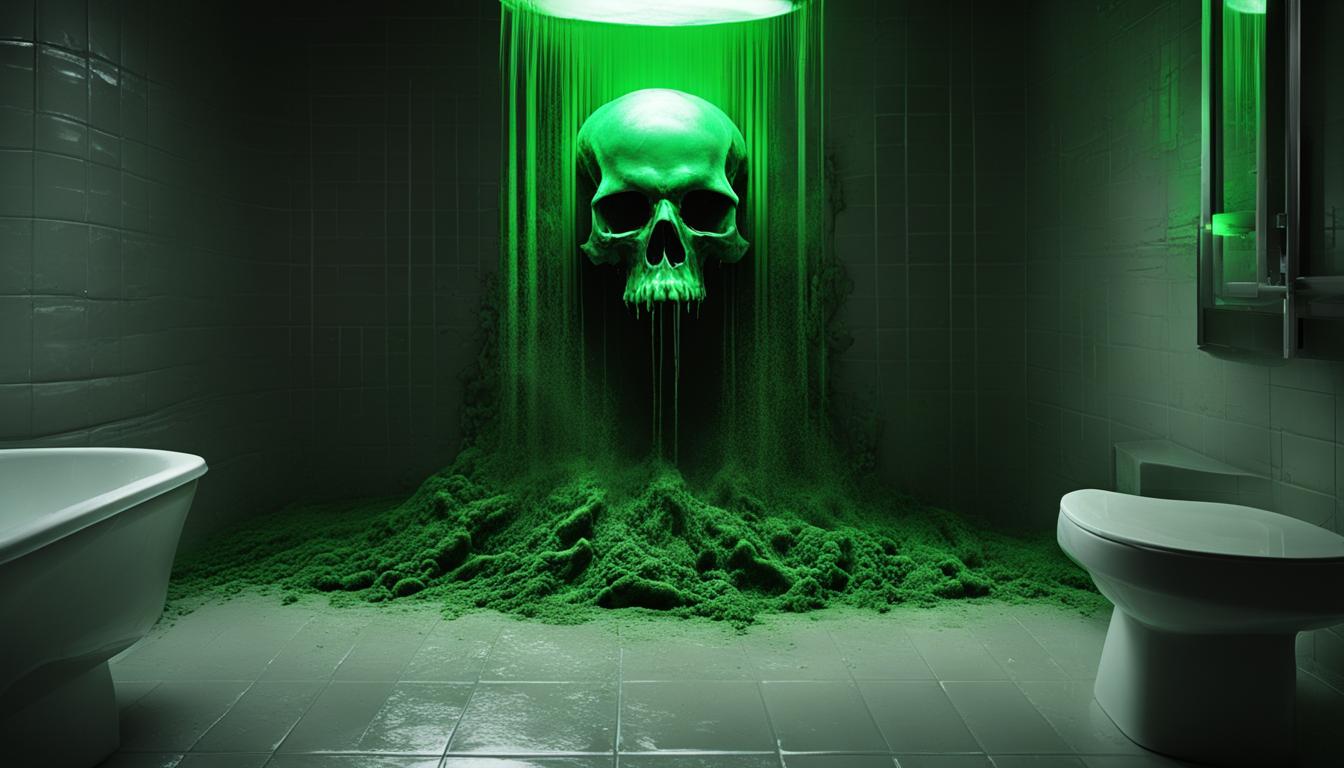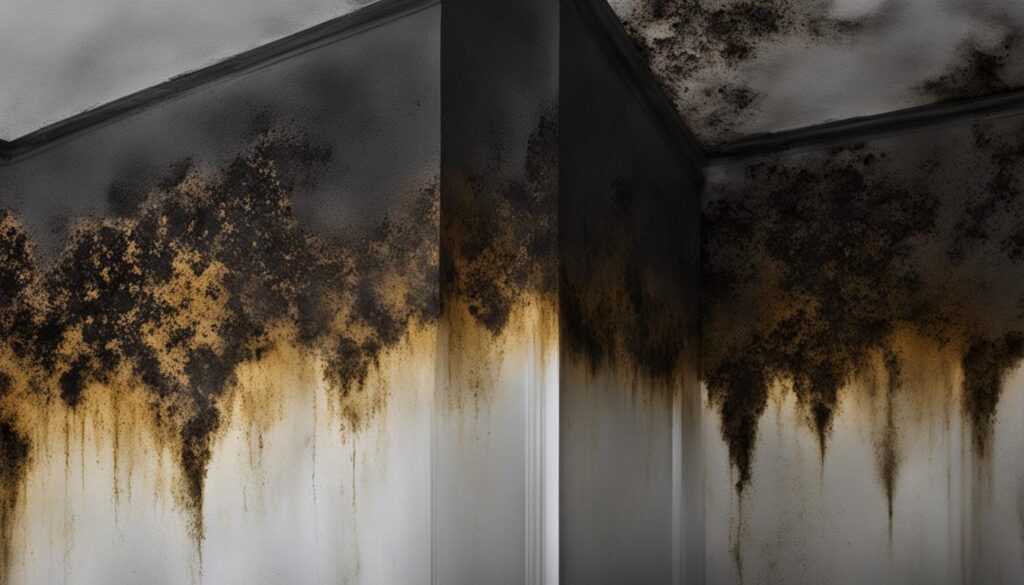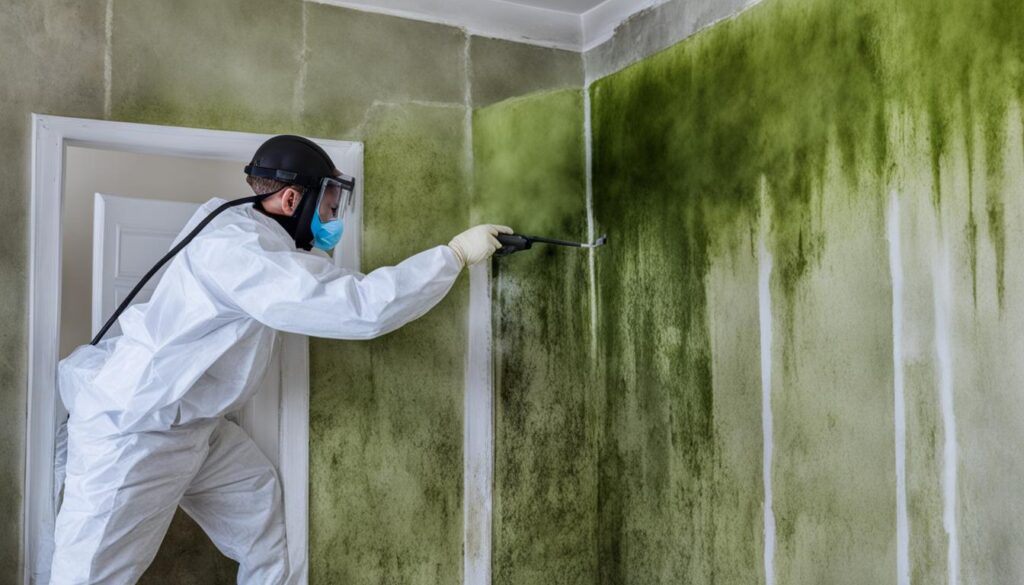
Unveiling Hazardous Residential Mold Types
When it comes to mold in our homes, not all types are created equal. Some molds pose more significant health risks than others, making it crucial to identify the most hazardous mold commonly found in residential areas. Understanding these molds can help you take appropriate measures to protect both your home and your health.
In this article, we will explore the different types of mold commonly found in homes, focusing on the most dangerous varieties. We’ll discuss the health risks associated with mold exposure, the symptoms of mold poisoning, and the importance of mold identification. Additionally, we’ll delve into the significance of professional mold testing and the role of indoor air quality testing in maintaining a healthy living space.
Key Takeaways:
- Toxic black mold, also known as Stachybotrys chartarum, is one of the most hazardous mold types commonly found in residential areas.
- Mold exposure can lead to various health risks, including respiratory issues, allergies, and even neurological symptoms.
- Identifying the signs and symptoms of mold poisoning is crucial for early detection and prevention.
- Professional mold removal and remediation services are essential to effectively eliminate mold growth and prevent future outbreaks.
- Regular indoor air quality testing is necessary to ensure a healthy living environment free from mold and other contaminants.
Understanding Mold and its Health Risks
Before identifying the most hazardous mold types commonly found in residential areas, it is crucial to understand the potential health risks associated with mold exposure. Mold spores can enter your home through windows, doors, and even clothing, leading to various health problems if left untreated.
Exposure to mold can cause a range of symptoms, commonly known as mold poisoning. These symptoms can differ from person to person and depend on factors such as the individual’s sensitivity, the amount and duration of exposure, and the type of mold present. Some common symptoms of mold poisoning include:
- Allergic reactions: Sneezing, coughing, itchy eyes and throat, runny nose
- Asthma attacks: Wheezing, shortness of breath, chest tightness
- Respiratory issues: Difficulty breathing, chronic cough, sinus congestion
- Headaches and migraines
- Fatigue and weakness
- Skin irritation and rashes
- Digestive problems: Nausea, diarrhea, abdominal pain
These symptoms can be particularly concerning for individuals with weakened immune systems, respiratory conditions, or allergies. If you notice any of these symptoms persisting or worsening in your home, it is crucial to address the mold issue promptly to protect your health.
“Untreated mold exposure can lead to severe health complications, especially if you have pre-existing respiratory or immune system conditions. It is essential to take mold issues seriously and seek professional help for proper remediation.”
Identifying and addressing mold issues in your residential spaces is of utmost importance for maintaining a healthy living environment. By proactively addressing mold growth and implementing proper remediation measures, you can mitigate the health risks associated with mold exposure.
To better understand the health risks of mold exposure and protect yourself and your loved ones, let’s delve further into the identification and management of hazardous mold types commonly found in residential areas in the next sections.
Mold Poisoning: A Closer Look
| Mold Type | Health Risks |
|---|---|
| Aspergillus | Allergic reactions, respiratory infections, lung inflammation |
| Penicillium | Allergic reactions, sinusitis, lung inflammation |
| Cladosporium | Allergic reactions, asthma attacks, sinusitis |
Identifying Toxic Black Mold
When it comes to mold infestations in residential areas, one type stands out among the rest for its toxic and dangerous nature: toxic black mold, scientifically known as Stachybotrys chartarum. This mold can pose significant threats to both your property and health, making it crucial to understand how to identify and address it promptly.
Toxic black mold typically appears as dark greenish-black patches on surfaces such as walls, ceilings, and floors. It thrives in damp and humid environments, making bathrooms, basements, and areas affected by water leaks common breeding grounds.
Identifying toxic black mold requires careful observation and awareness of its characteristics:
- Color: As the name suggests, this mold variety is primarily black in color. However, it can also have a greenish appearance.
- Texture: The texture of toxic black mold is usually slimy or wet, unlike other types of molds that may appear powdery or fuzzy.
- Odor: One of the distinct features of toxic black mold is its pungent, musty odor. If you notice a strong and unpleasant smell in a particular area of your home, it could be a sign of a mold problem.
- Growth Pattern: Toxic black mold tends to grow in clusters or colonies, forming large patches that spread rapidly if left untreated.
It is important to remember that visual identification alone may not always confirm the presence of toxic black mold. To ensure accurate identification and determine the severity of the infestation, professional mold testing services can provide a comprehensive assessment of your property.
“Toxic black mold, scientifically known as Stachybotrys chartarum, is a dangerous mold type that requires immediate attention. Its distinct black or greenish appearance, slimy texture, pungent odor, and rapid growth patterns make it easy to identify. However, professional mold testing is recommended for accurate assessment and proper remediation.”

Dangers of Toxic Black Mold
The presence of toxic black mold in your home can have serious repercussions for both your property and health. Exposure to its spores can lead to a range of health issues, including:
- Respiratory problems
- Allergic reactions
- Headaches and migraines
- Fatigue and weakness
- Memory loss and difficulty concentrating
- Joint and muscle pain
Prolonged exposure to toxic black mold can exacerbate these symptoms and even lead to more severe health complications. Therefore, it is crucial to take immediate action if you suspect the presence of this mold in your home.
Professional Mold Remediation
Toxic black mold and other hazardous mold types should never be handled as a DIY project. Professional mold remediation services are equipped with the necessary expertise and tools to safely and effectively remove mold from your property.
By enlisting the services of experienced professionals, you can ensure that the mold is thoroughly identified, contained, and eliminated. They will also address the underlying causes of the mold growth to prevent future infestations.
Remember, the health and safety of your home and family should always be prioritized when dealing with toxic black mold and other dangerous molds.
| Mold Identification Tips | Key Takeaways |
|---|---|
| Pay attention to musty odors, especially in areas prone to moisture. | Mold identification requires a thorough understanding of the characteristics and growth patterns of each type. |
| Visual inspection can provide initial clues, but professional mold testing is recommended for accurate identification. | Professional mold remediation services ensure safe and effective removal of toxic black mold. |
| Be aware of any health symptoms or reactions that may be related to mold exposure. | Prevention, proper ventilation, and maintaining low humidity levels are essential in mold prevention. |
Common Hazardous Mold Types
Apart from toxic black mold, there are several other hazardous mold types that homeowners should be aware of. It is crucial to identify these molds in order to address any potential risks they may pose in residential environments. Let’s explore some of the most dangerous household molds and their identification features:
1. Aspergillus
Aspergillus is a common mold that can be found both indoors and outdoors. It typically grows on decaying organic materials, such as wood or plant debris. While most types of Aspergillus molds are harmless, a few can produce toxins that can cause respiratory problems, especially in individuals with weakened immune systems.
2. Penicillium
Penicillium is another mold commonly found in homes. It thrives in damp and humid environments, like bathrooms and basements. Some species of Penicillium can produce mycotoxins, which can lead to allergic reactions, respiratory issues, and even chronic sinus infections.
3. Cladosporium
Cladosporium is a mold that can grow on damp surfaces, such as carpets, wallpaper, and insulation. It is often identified by its olive-green or brownish-black color. Cladosporium can trigger allergic reactions, asthma attacks, and other respiratory symptoms.
It’s important to note that these mold types can vary in appearance and may require professional mold testing for accurate identification.
“Identifying hazardous molds in your home is essential to protect your property and the health of your family.” – Your Name, Mold Remediation Expert
Proper identification of hazardous mold types is the first step towards effective mold removal and remediation. If you suspect the presence of any dangerous molds in your home, it is recommended to consult with a professional mold remediation service for thorough testing and safe elimination of mold.
By taking proactive measures to identify and address the presence of hazardous mold, you can ensure a healthy living environment for you and your loved ones. In the next section, we will discuss the importance of mold removal and remediation services in mitigating the risks associated with mold growth in residential spaces.
The Importance of Mold Removal and Remediation
Once you have identified hazardous mold in your residential space, it is crucial to address the issue promptly. Mold can cause various health problems and damage to your property if left untreated. Hiring professional mold removal services and conducting thorough mold testing are essential steps in ensuring effective remediation.
The Significance of Professional Mold Removal Services
Professional mold removal services offer expertise and specialized equipment to safely and effectively remove mold from your home. Attempting to remove mold on your own without the necessary knowledge and tools can lead to inadequate results and potential health risks. By hiring professionals, you can trust that the mold removal process will be thorough, minimizing the chances of mold regrowth and ensuring a safe living environment for you and your family.
The Importance of Thorough Mold Testing
Mold testing is a crucial step in the mold remediation process. It helps identify the extent of mold contamination, determine the specific type of mold present, and assess the potential risks associated with it. Professional mold testing involves collecting air, surface, or bulk samples from your home and analyzing them in a laboratory. This comprehensive testing provides accurate results and valuable insights that guide the remediation process, ensuring that all mold sources are identified and effectively addressed.
Thorough mold testing plays a vital role in the success of mold removal and remediation. By identifying all areas affected by mold growth, professionals can develop a customized remediation plan tailored to your home’s specific needs. This approach ensures that every mold spore is eradicated, significantly reducing the risk of mold recurrence and safeguarding the health and well-being of your household.
| Benefits of Professional Mold Removal services | Benefits of Thorough Mold Testing |
|---|---|
| Safe and effective removal of mold | Accurate identification of mold type |
| Elimination of potential health risks | Assessment of the extent of mold contamination |
| Prevention of mold regrowth | Evaluation of the risks associated with mold |
| Customized remediation plan | Guidance for the remediation process |
By prioritizing professional mold removal services and thorough mold testing, you can ensure that your home is free from mold, providing a clean and healthy environment for you and your loved ones. Don’t hesitate to reach out to experts in mold remediation and testing to address any mold-related concerns effectively.

Ensuring Indoor Air Quality after Mold Remediation
Once the mold removal and remediation process is complete, it is essential to prioritize the assessment and maintenance of indoor air quality. By doing so, you can prevent future mold growth and ensure a healthy living environment for you and your family.
Indoor air quality testing is a crucial step to identify any lingering mold spores or other contaminants that may affect the air you breathe. This testing involves professionals using specialized equipment to measure air quality parameters such as humidity, temperature, and the presence of airborne particles.
By conducting indoor air quality tests, you gain valuable insights into the effectiveness of the mold removal services and remediation measures taken. It allows you to identify potential areas of concern that might require further attention or follow-up treatment.
Moreover, regular indoor air quality testing provides peace of mind, knowing that your home’s air is safe and free from harmful pollutants. It is particularly important for individuals with respiratory conditions or allergies, as poor indoor air quality can worsen their symptoms.
“Maintaining indoor air quality is essential after mold remediation. By investing in professional indoor air quality testing, you can protect your family’s health and prevent future mold-related problems.”
Here are some additional tips to ensure a healthy indoor living environment:
- Keep humidity levels in check, ideally between 30-50%, to discourage mold growth.
- Properly ventilate high-moisture areas such as bathrooms and kitchens to prevent excessive condensation.
- Regularly clean and vacuum your home to minimize dust and allergens.
- Use air purifiers or air filtration systems to remove airborne contaminants.
- Ensure adequate ventilation and circulation of fresh air throughout your home.
- Keep your HVAC systems well-maintained and replace air filters regularly.
Remember, maintaining indoor air quality goes hand in hand with mold removal services. By prioritizing both, you can enjoy a healthier and safer living environment.
| Benefits of Indoor Air Quality Testing | Tips for Ensuring Indoor Air Quality |
|---|---|
|
|
Conclusion
In conclusion, it is essential to identify and address the most hazardous types of mold commonly found in residential areas to protect your home and health. By understanding the risks associated with these molds, you can take appropriate measures for mold removal and remediation. Additionally, ensuring indoor air quality is crucial for preventing future mold growth and maintaining a safe living environment for you and your family.
If you suspect mold issues in your home, it is advisable to seek professional assistance for mold assessments, prevention, and remediation services. For reliable and comprehensive solutions in Florida, contact Fix Mold Miami at 305-465-6653. Their experienced team can help you identify and address mold problems, ensuring the well-being of your home and loved ones.




